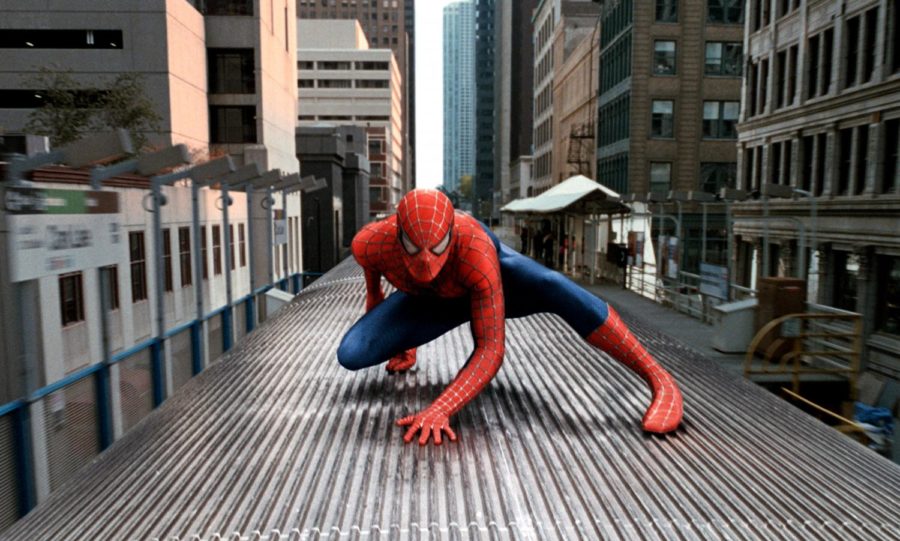Shiralkar: Remembering ‘Spider-Man 2’
Columnist Parth Shiralkar reminisces of “Spider-Man 2,” highlighting how beautiful and noteworthy the movie was in the grand scheme of hero tropes and films.
April 4, 2020
Filmmaking is a very complex process. Put a bunch of people with greatly distinct personalities and very little patience in an enclosed space and there’s only a few outcomes you can expect: a murder mystery or a nice project. When Sony pulled the plug on Sam Raimi’s fantastic “Spider-Man” series, they said it was over “creative differences” with the director. All of this, I think, was just hogwash to distract from the absolute artwork that is “Spider-Man 2.” Even though some people tend to call the film overrated, I will not gatekeep movie tastes of individuals; I respect the delusion wholeheartedly. Spoilers ahead.
I’m not a comic book person so I personally have no idea whether “Spider-Man 2” actually was faithful to the comics. Tobey Maguire has been established as the perennial loser Peter Parker in the first installment of the series. Maguire is goofy, fun, depressed for quite a bit, having killed his best friend’s father (Green Goblin), struggling with his relationship with Mary Jane (MJ) and coming to terms with his other identity.
From the moment the film starts, we are presented with Peter’s life: juggling jobs as he tries to find that perfect balance between saving lives and salvaging his relationship. With great power comes great responsibility and an identity crisis. It’s a tough choice. No matter how hard he tries to shut the Spider-Man side of him down, Peter realizes that he will always jump up at the first sign of danger. The hero isn’t Spider-Man, it’s Peter himself.
Repressing his feelings for MJ only affects his attempts at keeping the city safe. Alfred Molina plays Dr. Otto Octavius (Doc Ock), the nobly tragic scientist who loses his wife to a poor decision and bodily control to his AI-powered robotic tentacles. “Spider-Man 2” is a masterpiece not because it gets the hero right but because it nails the villain as well. We can’t help but feel sympathy for the genius trapped behind the AI, slowly losing control.
Peter Parker makes the call to give up the superhero business and focus on his normal life, a big part of which is MJ. But alas, things comes full circle, as evil Doc Ock attempts to kill MJ. Spider-Man is forced out of his sabbatical, back into the dual life he wanted to avoid for the very person who inevitably pulled him back in. “Spider-Man 2” – and the series in general – has made use of the best visual effects available at the time. This just speaks to my earlier point about directors being given more creative reign. The finished product is a series of action sequences so entertaining they deserve recognition on their own.
The final action scenes are exquisitely choreographed mayhem, from the clock tower scene to perhaps the most notable scene from the film: the train stopper. Sam Raimi managed to do in this movie that even the newer films have perhaps struggled to do. Tom Holland’s version is great, Andrew Garfield is passable. But in that final scene, it all comes together when the people that he saved help him get to safety.
Maguire yanking on several webs to slow the train down even as his costume is torn up from his stretching muscles, what an iconic scene. The true definition of shredded and ripped. And in the midst of all that chaos, someone says, “He’s just a kid… no older than my son.” Before this scene, people never realized that their savior wasn’t an able-bodied middle-aged cop or a rebellious hardened detective or a bored martial artist; no, he’s just your friendly neighborhood Spider-Man.
“Spider-Man” was the first film ever to break the $100 million number in its first week. As far as superhero movies go, Raimi’s series paved the way for films in the future. This is a hill I have leased out indefinitely and am willing to die on. Plus, for someone who has been working closely with journalists and newsrooms for a long time now, I think the reporter-cum-superhero trope is nice. For all you and I know, the Iowa State Daily employs someone moonlighting as a masked vigilante. One can only imagine. Stay hydrated.







